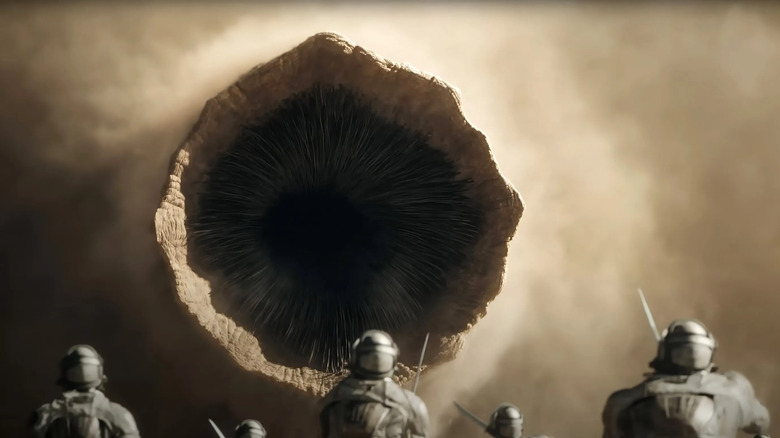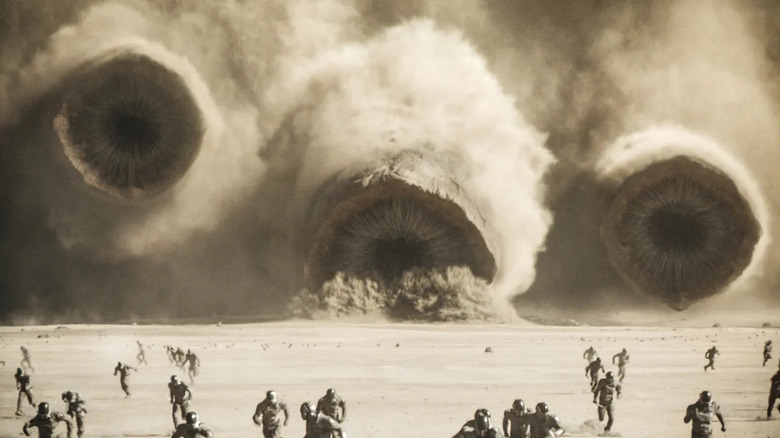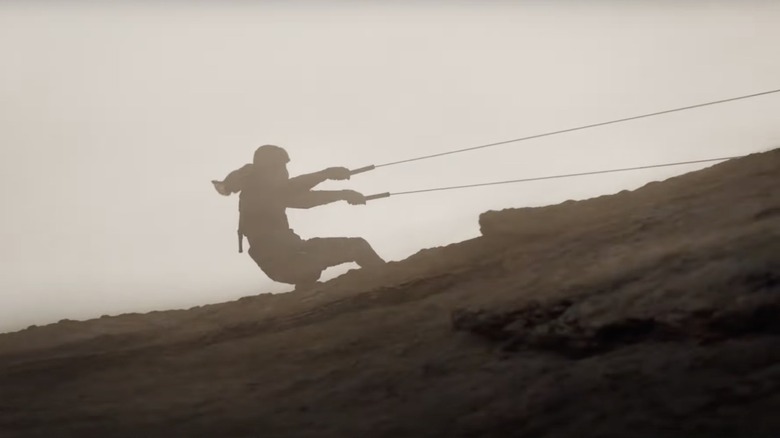How Are Dune: Part Two's Sandworm Thumpers Retrieved? Here's A... Crappy Theory
In Denis Villeneueve's sci-fi epic "Dune: Part Two," the desert-dwelling Fremen have learned a clever way to live in the wastelands of Arrakis, even as mile-long destructive sandworms furtively burrow around under their feet. For one, they have discovered that the sandworms are attracted to steady, regular ground beats, and have altered their walking to be irregular in response. The Fremen have also learned how to ride on the backs of the sandworms using an elaborate and dangerous lassoing method that takes years to refine.
A Fremen worm-rider will climb to the top of a sand dune and insert a small, forearm-length device called a thumper into the ground. A thumper, as its name implies, regularly pounds on the ground, deliberately attracting a sandworm. When a worm explodes out of the sand and charges for the thumper, the Fremen rider will fire grappling hooks into its body, hooking open the worm's creepy breathing flaps. They can then climb up onto the speeding worm and keep it above ground by holding its flaps open. Easy as pie.
Of course, a question arises: what happens to the thumper? Did the worm eat it? Does the Fremen rider grab it very quickly before firing their grappling hooks? It seems that the Fremen, whose resources are very limited, wouldn't want to waste thumpers by leaving them behind or feeding them to their worm-mounts. It likely takes a lot of time and materials to make just one thumper; the Fremen probably only have a limited supply.
In a new interview with Gizmodo, Villeneuve was grilled about the thumpers, and he had a theory as to what happens to them. It involves worm poop.
The lair of the white worm
The ecology of Arrakis is bizarre. It's a desert planet that plays host to sparse flora and fauna, and in Frank Herbert's original novel, Arrakis is described as hosting "saguaro, burro bush, date palm, sand verbena, evening primrose, barrel cactus, incense bush, smoke tree, creosote bush [...] kit fox, desert hawk, [and] kangaroo mouse." The sandworms, as Herbert explores in several "Dune" sequels, feed on sandplankton and their more mature form, sandtrout. It seems that sandtrout encyst water sources and eventually grow into the massive worms seen in the story. The sandworms essentially feed on themselves, giving birth to their own food source.
Some fans assume that the spice melange, found only on Arrakis, is actually worm poop, i.e. the spore left behind by a species that is essentially devouring itself. That theory is not confirmed by any texts. As far as we know, the worms digest and leave behind scat just like any animal. This is certainly the theory posited by Denis Villeneuve, a theory he hastily invented when pressed about the potentially eaten thumpers used by the Fremen:
"Yeah, it's a thing you ask yourself. Is there something that they can find back there out of the digestive system of the worm? [...] In 'Part One' we're trying to avoid the sandworms as much as possible. In 'Part Two,' you see that the Fremen embrace this beast and use them as a way of traveling in the desert. I thought it was super poetic and I absolutely loved it. But yeah, it raises a question. I'm sure the Fremen thought about that."
There are no scenes of Fremen digging through piles of worm poop like Laura Dern in "Jurassic Park," but Villeneuve implied that's exactly what's happening when it comes to thumper retrieval.
Annelid antics
Villeneuve continued theorizing, clearly not having given the latter much thought before making his movie:
"I'm sure that there's a way to recycle because it's a culture that is all about recycling. It's a bit like people living in space. It's an environment that's so harsh and they are very clever people. So there's a way of recycling those thumpers to find them back. We should ask a Fremen."
It seems that thumper retrieval wasn't of paramount importance to Villeneuve. Perhaps thumpers are easily constructed, allowing the Fremen to build as many as they might need. Perhaps they have regular access to an abandoned Atreides storehouse containing millions of thumpers and they're not yet concerned about running out. Indeed, in "Dune: Part Two," the Fremen find a forgotten Arteides bunker containing nuclear missiles. It seems that such a thing should be more carefully watched, but they are needed for the convenience of the film's plot.
As for worm poop, Villeneuve doesn't depict any on screen. Some "Dune" fans have posited that the worms don't digest nutrients or grow like ordinary animals because they aren't wholly organic. Some wilder theories have said that the sandworms are ancient stone-based machines that contain internal furnaces. In Herbert's "Children of Dune," Paul's son Leto II says the worms came from another planet and ruined Arrakis:
"The sandtrout [...] was introduced here from some other place. This was a wet planet then. They proliferated beyond the capability of existing ecosystems to deal with them. Sandtrout encysted the available free water, made this a desert planet [...] and they did it to survive. In a planet sufficiently dry, they could move to their sandworm phase."
In "God Emperor of Dune," Leto II becomes a half-man, half-sandworm monster for 3,500 years. This series is wild.


